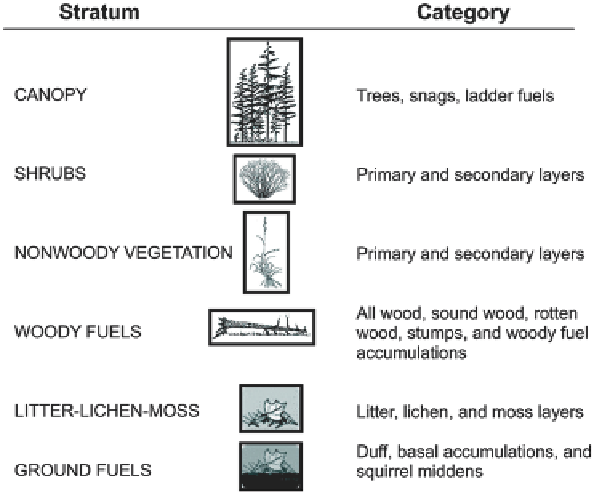Agriculture Reference
In-Depth Information
Fig. 7.2
A general description of the elements in the FCCS. (Ottmar et al.
2007
)
fuel component properties with the identified FCCS “fuelbed.” This fuelbed then
becomes a category in the classification. The system uses ecoregion, stand structure,
and site history classification variables to identify fuelbeds in the field (Riccardi
et al.
2007a
). FCCS is also somewhat special in that it also contains its own fire
behavior model tuned for the FCCS fuel components (Sandberg et al.
2007
).
The advantage of developing opportunistic classifications is that new fuel com-
ponents and properties can be added to the classification with little effort. The
FCCS has quantified over 20 fuel properties for several fuel components in each
fuelbed in the classification (Fig.
7.2
). Opportunistic classifications can be used to
represent fuels at any scale; FCCS classifications have been developed for small
areas, such as plots and treatment units, and for large regions, such as the entire
USA (McKenzie et al.
2007
). These classifications are also easy to understand and
build, and they can be modified and revised by anyone with any level of experience.
In addition, the classes represent actual fuelbeds that are extensively documented
in the field.
There are some shortcomings in the opportunistic approach that may limit their
application. Few opportunistic classifications are able to consistently and uniquely
identify a fuelbed in the field (Ottmar et al.
2007
). Most rely on the expertise of the
fuel sampler to match the observed fuelbed conditions to the categories in the classi-
fication, or to identify a class based on the ancillary vegetation and site classification
criteria used to describe the fuelbed (e.g., photo series). The FCCS, for example,
does not contain a key to directly identify a fuelbed from fuelbed characteristics.

Search WWH ::

Custom Search